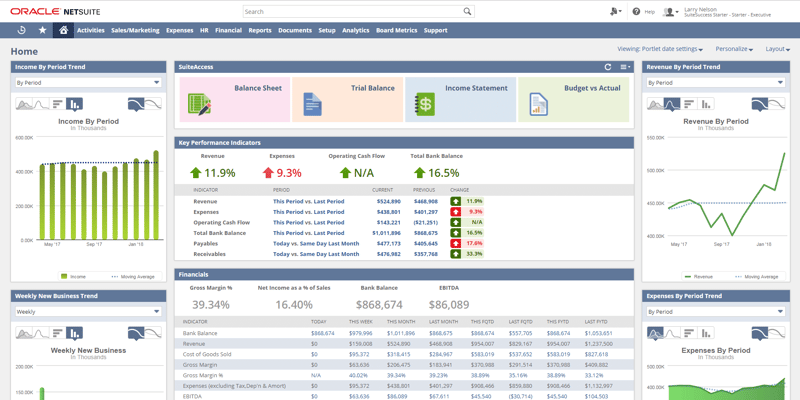NetSuite and the Power of Simplicity
''Although a software system is immaterial and not an object per se, many of its aspects embody beauty as simplicity: the design or concept’s efficiency, the structure’s purity and clarity, the code’s stringent organization, the running artifact or behavior’s reliability, and the system’s usability, its versatility, and its longevity as it morphs over time. And yet, the beauty of simplicity is easily spoiled by poor decisions, misguided features, and outdated assumptions about efficiency capstones. Particularly in IT, with its ethereal nature, simplicity is relegated to the inner layers, and too often remains unseen, implicit, and largely underappreciated.’’ - IEEE Computer Society, November 2013
An ERP solution’s mission is to integrate business processes and deliver simplicity as a key benefit. In this regard its architecture simplicity and scalability needs to be the focus.
Choosing an ERP solution
When deciding to change their ERPs, companies, often concentrate their attention to functionalities requirements. As these evolve with time, it is paramount to keep sight of this progressive need as a framework, so it becomes a reality. The architecture and the total cost of ownership then remain simple and manageable.

Besides license, implementation, and maintenance costs, there are many perspectives to this, such as multiple:
- Software vendors;
- Technologies to deal with;
- Middleware;
- Interfaces/user interfaces, and how to manage, adopt and get used to them;
- Resources and knowledge to keep internally to contain any complexity.
For the latter, bear in mind the instability of a complex architecture increases the risk of failure and the difficulty to identify, isolate, reproduce, and resolve issues as they happen.
Since we are talking about simplicity, let’s see how a system architecture around an ERP solution can easily become cumbersome. It is thus essential to target an ERP which can avoid that, while offering possibilities that respond to your requirements.
It’s all about finding the right ERP to fit your company's business needs
When system providers claim they have solutions for all these mentioned perspectives, you must inquire regarding how integrated their solutions are.
Let’s consider a good core ERP from a business process perspective, meaning these key processes, among others, are well covered:
- Order to cash;
- Procure to pay;
- Finances.
You still must keep an eye on some of these functionalities:
CRM
From a forecasting and sales automation standpoint, most ERPs do not offer companies with a CRM as an integrated module. Or when they do, only with very limited capabilities. So, if the CRM is an important requirement, you should already have a CRM as a standalone system. Interfaces must then be put in place to be able to talk to your ERP, not to mention any requirement to add middleware to enable this interface.
Let’s say you need to manage customers’ documents, files and versions. You will certainly need a document management platform linked to your ERP or transactions. This will help you to keep track of all your customer documentation, such as:
- Contracts;
- Specifications;
- Designs.
Even if this platform is integrated to your ERP, it will not be part of your master data. The platform will remain a separate file repository, so tracking documents and specification versions will not be so straightforward.
Finance
Another limitation which normally imposes additional software or add-ons to ERPs are financial planning and budgeting. Standard financial ERP functionality does not suffice to cover all dimensions in financial planning and budgeting. Indeed operational, capex, and project budgets, as well as all versions that may be required in different scenarios to compare against actuals might not be part of the ERP.
If you need planning and budgeting functionality either now or in the future, be prepared for more pieces of software, vendors and integration.
Standard Business Functionality
Standard business functionality is normally covered by the core ERP, but specific industry functionality like those for Retail, Apparel, Software, Services and other will rely on third party solutions. In most cases, these are developed by the vendor partners (sometimes called VARs – value added resellers or ISVs - independent software vendors) to be added and integrated as well into your core ERP.
These verticals may be the most important piece of your architecture, since they bring specific functionalities sometimes essential for your business to run. Therefore, don’t underestimate this potential requirement, which will certainly force you into more vendors, complexity, and interfaces prone to failure and maintenance.
Reporting and Business Intelligence
Moreover, there is always the reporting and business intelligence requirement. Most ERPs do not offer an integrated solution to address this requirement. Consequently, not only do we need to integrate an additional solution, but also work to synchronize databases between the reporting and Business Intelligence (BI) tool and the core ERP. By doing so, your reports can be minimally close to reality and the information can be useful for decision making.
Depending on the BI and reporting tool adopted, you will also have to work on a heavy piece of middleware for the proper extraction, transformation and loading (ETL) of the data from the ERP source. You will then be able to create dimensions and cubes for the BI tool to be functional and useful.
In complement, analytics components to this BI product will be required and bring additional complexity to the picture. Experienced professionals, either external or internal, would be wise to support it.
Do not underestimate this task and complexity; this is normally a major source of frustration in ERP implementations since visibility across the business processes is one of the most expected benefits of an ERP.
So, what are the options to avoid a situation like this?
NetSuite is the answer
NetSuite is a scalable product, a cloud solution ERP which includes all the above-mentioned components:
- Core financials;
- Complex budget planning;
- Project management;
- Revenue recognition;
- Sales quotes from a CRM;
- Sophisticated shipping.
 NetSuite offers verticals for each major industry segment with all specific functionality embedded in its core modules, such as Manufacturing, Wholesale Distribution, Apparel, Software, Services and Non-Profit, among others.
NetSuite offers verticals for each major industry segment with all specific functionality embedded in its core modules, such as Manufacturing, Wholesale Distribution, Apparel, Software, Services and Non-Profit, among others.
As such, NetSuite scalability is best suited to eCommerce and Retail businesses. The solution allows one to abandon platforms to support marketplaces like Magento. It also keeps you from further support needs or maintaining data synchronization or multiple master data entry, not to mention the integration.
NetSuite also spans functionalities from HR to Supply Chain in a distinguished user interface. The suite is flexible enough to give users the ability to navigate as they prefer, which facilitates user adoption and benefit realization.
Find out more about SuiteSuccess - NetSuite's industry-specific cloud solution by downloading the white paper:
Besides offering all this from a single platform and strong vendor, Oracle, NetSuite’s footprint is zero to your machines and servers. It is the main SaaS ERP on the market, run by more than 40,000 companies across the globe since 1998. A true SaaS that allows you include functionalities and pay per use instead of pushing you with licenses you are uncertain you want to buy.
A true SaaS ERP, like NetSuite, keeps all customers under the last system version, with no need for expensive upgrades and retrofit tests. This ensures no piece of your cumbersome architecture falls apart when you upgrade the core ERP.
In your ERP selection, I invite you to learn more about NetSuite and how companies across the globe are evolving with an ERP capable to evolve with them and deliver efficiency, scalability, and the lowest cost of ownership.
See how so many companies soar with the number one cloud ERP software, contact us!






